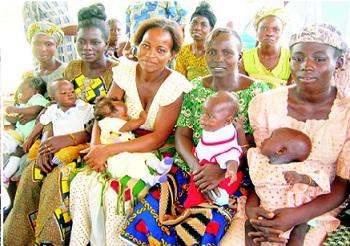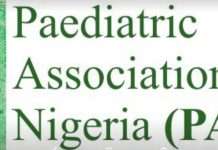
Against the backdrop of meeting the Millennium Development Goals (MDGs) target of reducing child mortality rates by a third in 2015, which is less than four months from now, there are indications that Nigeria is far from reaching the goal, as the country ranks the second largest contributor to the under-five and maternal mortality rates in the world, according to UNICEF.
Although analyses of trends show that the country is making relative progress in reducing infant and under-five mortality rates, the pace is still too significantly slow to achieve the MDG of reducing child mortality by a third by 2015.
Maternal mortality, according to the World Health Organisation (WHO), “is the death of a woman while pregnant or within 42 days of termination of pregnancy, irrespective of the duration and site of the pregnancy, from any cause related to or aggravated by the pregnancy or its management but not from accidental or incidental causes.”
Infant mortality, on the other hand, refers to the death of infants and children under the age of five. In 2011, 6.9 million children under five reportedly died down from 7.6 million in 2010, 8.1 million in 2009 and 12.4 million in 1990. Global statistics on the challenge reveal that child mortality is more prevalent in the sub-Saharan Africa with about half of child deaths being recorded there.
Lending its voice to that of UNICEF, the Nigeria Human Rights Commission (NHRC) recently hinted that Nigeria was one of the countries in the world with high maternal and infant death rates with a ratio of 545-630 per 100,000 live births, or 75 per 1,000 live births on the infant mortality index, according to the United Nations, UN.
According to the UNICEF statement, “Every single day, Nigeria loses about 2,300 under-five year olds and 145 women of childbearing age; this makes the country the second largest contributor to the under–five and maternal mortality rate in the world.”
Relevant questions
The question that should arise from the facts and figures presented so far is, having received the charge to achieve these maternal and infant MDG goals for the past 14 years, what has kept Nigeria lagging behind in meeting the 2015 deadline? Or more specifically, one should be compelled to ask stakeholders in the country, “Whose responsibility it is to reduce the alarming rate of maternal and child mortality to the barest minimum?”
The most relevant group of persons to answer the first question are those at the helms of affairs of both federal and state ministries of health, because they are accountable for all the funds released into the ministries for this singular purpose. In fact, it is an open secret that, so far, several international agencies have donated large chunk of dollars to Nigeria for the reduction of mortality in this area; yet Nigeria still ranks the second largest contributor to maternal and child mortality rate globally.
The other question raised about the commitment of practitioners in the health care industry to this cause is also very crucial. If all stakeholders had taken it as a priority to decisively tackle the challenge of infant and maternal mortality, we should be basking in the euphoria of successful accomplishment by now. Observations, however, clearly suggest that most members of the health care team have left the responsibility to doctors and nurses. Only when a case becomes complicated and menacing do others start making frantic efforts to make their services count.
Rational steps
Now that it is evident that we may not meet the MDGs deadline, should we discontinue the quest to achieve the laudable goals, while countless infants and their poor mothers succumb to the cold hands of death? The obvious answer is no – we mustn’t throw the baby away with the bathwater. Rather, we should be thinking of what steps to take to accelerate our pace.
We may borrow a leaf from the strategic partnership between the Nigeria Human Rights Commission (NHRC) and the White Ribbon Alliance for Safe Motherhood in Nigeria (WRAN), which was engendered by the need to protect the rights of mothers in Nigeria. In a recent conference organised by the partners, a Memorandum of Understanding was drafted to spell out a working relationship for the implementation of respectful maternity care in Nigeria. They called it the “Respectful Maternity Care Charter”.
The challenge here is, if human rights organisations could form a partnership on issues relating to maternal and child health care in Nigeria, then health care practitioners cannot be excused in any way for not doing even more, having sworn to commit themselves to the task of saving lives.
Removing barriers
Barriers to progress also have to be dislodged if we expect to fulfil our mission in good time. A technical partner of the Lagos State Civil Society Partnership (LACSOP), Mrs Dede Kadiri, after surveying the environments of some Primary Health Centres (PHCs) in Lagos, said, “We were able to assess 30 PHCs in 2013 and found out four critical issues, firstly, postpartum haemorrhage; out of the 30 PHCs we went to, we found out that almost all of them were unable to handle postpartum haemorrhage. And most times, they don’t have equipment and ambulances for referral processes to send patients to the general hospital for attention.
“Secondly, to generate power supply, most PHCs still make use of candles and lanterns in the labour room; and thirdly, the attitudes of staff are resenting people off to use other alternatives such as private hospitals and traditional birth attendants. Finally, the problem of water supply and dirty boreholes are still very conspicuous.”
Also, a recent report by the Lagos State Chairman of the Society of Gynaecology and Obstetrics of Nigeria Dr Oluwarotimi Akinola, stated that the major causes of high maternal mortality rates in Nigeria are haemorrhage, infection, hypertensive disorder of pregnancy, obstructed labour and anaemia. He added that any efforts by the government to reduce maternal mortality rates in the country must address the root cause of delays in seeking health care, accessing it and receiving help at any centre.
There are also other barriers that are specific to rural areas as identified by stakeholders. Delivering a paper recently at an event organised by the National Council of Women Societies of Nigeria (NCWS), Hajiya Khadijat Mustapha Giwa of the FCT Health Department said the problems include lack of proximity of health care posts to people at the grassroots, non-functional health centres, unqualified health care personnel and illiteracy among the target groups which make them to resort to traditional birth attendants (TBAs).
Remedial strategies
There is no gainsaying the fact that the coverage and quality of health care services in Nigeria have continued to fail women and children. Presently, less than 20 per cent of health facilities offer emergency obstetric care and only 35 per cent of deliveries are attended by skilled birth attendants.
To remedy the current situation, experts have suggested that maternal health conditions can only be improved by a three-stage programme, namely:
- Child spacing by self-determination of periods between the childbirths
- Professional care during pregnancy and childbirth
- Timely access to hospitals where complications can be treated by Caesarean cut.
It is also necessary to add that stakeholders must collaborate to form workable partnerships, with the objectives of implementing this programme, as well as providing conducive social and infrastructural environments for the improvement of the health of both mother and child.











